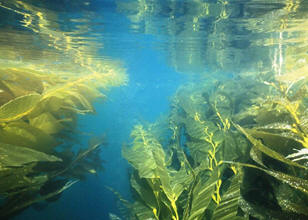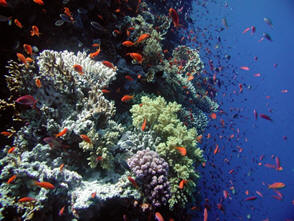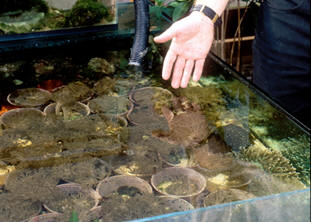|
Related FAQs: Best
Marine Set-Up FAQs 1, Best FAQs
2, Marine Set-Up 1, FAQs 2, FAQs 3, FAQs
4, FAQs 5, FAQs 6, FAQs
7, FAQs 8, FAQs 9, FAQs
10, FAQs 11, FAQs 12, FAQs
13, FAQs 14,
FAQs 15, FAQs 16, FAQs
17, FAQs 18, FAQs 19, FAQs
20, FAQs 21,
FAQs 22, FAQs 23, FAQs
24, FAQs 25,
FAQs 26, FOWLR Set-Ups,
Reef Tank Setups, Small Tank Setups, Moving Aquarium Systems,
Related Articles: Cookbook Approach to Marine System
Set-up and Setting up a Marine
System 2, Marine
Planning, Getting Started with a Marine Tank By
Adam Blundell,
MS, Technology: Putting on the
Brakes: How much is too much? By Tommy
Dornhoffer Marine
Maintenance, Reef
Set-Up, Reef
Maintenance, Marine Filtration,
Mechanical, Physical & Chemical, Components:, Water/Seawater, Tanks/Stands/Covers, Electrical, Light, Light Fixtures, Heating, Marine
Substrates, Aeration,
Circulation. Plumbing, Moving Aquariums,
The Conscientious Reef
Aquarist
Tips for Reef Tank Water Success
|
|
|
by Bob Fenner
|
|
“All is water” goes the first record of human writing (linear B,
Minoan); and this is indeed a true statement. Whether one interprets
this simple statement as to the nature of reality or our more mundane
efforts at marine aquarium keeping, it bears repeating that all
definitely begins with the water, and can also end badly with it.
Starting with high quality source water, carefully choosing, mixing
synthetic seawater, proper storage, and monitoring are simple, yet
extremely important matters. Herein are the highlights of what you can
and should do to assure good quality water for your captive reef
systems.
Source Water Quality Assurance:
Unless you’ve
been living under the proverbial rock, you’re doubtless aware of the
growing scarcity of “good potable water” most everywhere; including in
the United States. Times were that I and many other ornamental aquatics
writers, scientists and practitioners advocated the use of “plain tap”,
stating that “if it’s good enough for your potable purposes, it’s likely
fine for your salt water aquariums”. That was then; this is now… a time
of diminishing source water quality.
Likely using
most tap/mains water for mixing synthetic salt mix for fish only, and
fish with live rock (sans “corals”) is still fine for the majority of
people, places, but this is not the case for a growing number of
localities where folks keep reef systems. The standard mantra for reef
water quality is the less unknowns and contaminants the better… hence
the perceived and real need for new tapwater treatment.
Treatment for
folks who know that their source water is fine chemically may just
involve the use of a dechloraminator, a commercial product to remove
chlorine/chloramine sanitizer that’s been introduced by their
municipality to render it safe microbiologically.
IF you have
no inclination or ability to decipher your water provider’s analysis of
the water they supply to you, or doubts still regarding its suitability,
you will want to look into more involved water treatment methods. On the
low end technology wise are the use of contactors; some very
low-volume/production that “make” a few gallons per day by having a
pressurized or not tap source attached to their contactor body and
treated water dripped out the finish end. A larger version of this
approach, and very useful for heavy users (hundreds or more gallons per
day) is Poly-Bio-Marine’s (http://www.poly-bio-marine.com/)
Kold Ster-il filter.
Beyond this
unit and more refining still are various makes/models of reverse osmosis
(RO) units that provide “mostly water” by excluding solids, gasses,
other liquids. RO units are by and large the most practical, useful and
therefore popular means of providing desired quality and quantity of
known/good quality water for hobbyists and retailers. To mention it,
there is a further filtering possibility, De-ionization (DI) and even a
combination of DI w/ RO (RODI)… Suffice it to state that RO alone
removes 99.99 plus percent of all alone.
Salt Mix Selection:
There are actual, measurable differences in salt mix formulations and
quality; not least of which the issue of inconsistency has been a major
flaw with some manufacturers. Do your duty here to look about, consider
the input of other actual users (hobbyists), and not simply rely on the
at-times misleading claims of various makers. Do seek out recent,
up-to-date recommendations here as brands do come and go.
Are “reef
grade” mixes (often w/ simply boosted biomineral content) worth their
extra cost? This really depends on what else you have supplement
practice wise, use or not of calcium reactor et al. gear that might make
up for a perceived need for more Calcium, Magnesium.
What about
savings in cost by bulk buying? Large buckets (150-200 gallon), 3 50’s
per box, even club-split pallet purchases can really save money; and
other than opportunity costs of putting your money up front and storage,
there is no reason not to make such an investment. Some folks worry re
“clumping” (salt mixes are hygroscopic), but even clumped up salt mix is
fine to use, will dissolve completely over time.
Synthetic Mixing/Storing:
Though some manufacturers of synthetic salt mixes provide instructions
for simply mixing and using their products right away, I strongly
encourage you to instead pre-mix and store new water ahead of time for
your change outs. Newly mixed salt you’ll notice has a sharp smell to
it, and if you mix it by hand, it feels warm and a bit slimy… the warmth
is the exothermic physical reactions of the salts going into solution,
and the sliminess is mostly your skin dissolving from exposure to high
pH…
Pre-mixing
and storing allows for all the components of the salt mix to dissolve
completely and come to a homeostatic consistency. By recirculating and
heating such water in a dedicated chemically inert container you also
have the assuredness of readily-usable water should there be an
emergency need, such as wanting to set up an isolation, quarantine or
treatment tank.
My all-time
favorite containers for stored water are the Rubbermaid Brute line,
replete w/ sturdy covers and wheeled dollies if you’d like. These
polyethylene tools are tough and long-lasting. The submersible pump
mentioned you can use for both dissolving new mix as well as pumping to
your main/display tank.
Seawater System Maintenance: (including testing)
Yes; this topic could easily fill a book length tome on its own.
Straight off, I want to make it clear that regardless of having and
using the very best test gear, there is nothing better, more important
than your observation of your livestock to make known what your reef
water quality is, and alert you to the possible need to alter something.
For reef systems,
there are numerous tests, measures one can choose to perform when first
setting up; but for ongoing systems, these can be quite few. Unless one
sees a real need, weekly monitoring of specific gravity, calcium,
magnesium and alkalinity are all I do; yes, not pH necessarily. I rely
on all systems of size to be stable with simple partial water changes to
dilute metabolites and bolster alkaline earth concentrations (including
a smidgen of Strontium) and alkaline reserve with a measured “pinch” of
either dried or liquid two-part additives. This and a “squirt” of
iodide-ate are all I regularly add. On very large systems I’m a decided
fan of calcium reactor and ozone use (and RedOx measure).
There are “gear heads”
amongst us for sure; with as much invested in electronic probes, pumps
and alarms… These tools can be useful but should not be relied on alone
to monitor and administer all aspects of water quality. More biology,
and less technology is still my creed.
Are you surprised at
my lack of automated top off use for evaporation? Don’t be. My systems
are nearly completely covered on top, greatly reducing the need to add
water more frequently than the once a week partial change outs. “Your
mileage may vary”, so I would note the usual water level in your system
and have “just water” handy to top off periodically.
Changes:
I am very
aware of the naysayers here that eschew doing water changes… Some others
vehemently assert that there’s no need to do such removal of old and
replacement with new water. Rest-assured, there is NO simpler, safer and
assured method to preserving water quality than frequent partial water
changes. By regularly removing a portion of the water, best by vacuuming
part of the substrate, you’re diluting accumulating wastes, precluding
“Dead Sea syndrome”, and renewing needed macro- and micro-elements.
Further, if
you’re faced with an inexplicable issue of livestock health or loss,
when, where in doubt, change some large (25 percent, perhaps more)
amount of your system water. For sure you want to do what tests you can,
check all your gear… but if/when all else seems fine, remember the value
of dilution, re-centering your water quality back towards “new”.
About Natural Seawater (vs. Synthetic):
Using “the real thing” should be mentioned in an article that even
briefly covers the topic of reef aquarium water quality. Some might well
be tempted to use natural seawater, as it IS what the life we keep
originates in; but I assure you, the unnatural environments we control
(aquariums) are better served by synthetic mixes. The latter have no
issues of pests, parasites and pollution. And for folks that think or
hope to be saving money; do remember to figure in the cost of hauling
seawater, its longer storage and needed treatment. Phony/synthetic
saltwater is more convenient, longer-lasting in terms of sustaining life
and not yellowing, and less expensive overall. It’s not lost on me that
the biggest public aquariums (e.g. Atlanta, Baltimore/New England), even
ones near to the ocean use salt mix instead of real seawater.
If you’re still not
convinced that synthetic is better than natural for aquarium use, I want
to make sure that you’ve been warned to look into others accounts of
trouble with the real thing.
Cloze:
“It’s the water” goes an olde ad slogan for Olympia Beer (of
Tumwater, WA) “…and a lot more”. Certainly your starting water quality
is the beginning of success, or struggles in the reef aquarium interest.
If you begin with water issues, or add to poor water quality, all will
work against you: livestock health, poor appearance, pest algae issues
and more.
Marylou: Some possible pix (make it known if these are fine and
I’ll send full size to you… either FTP, Pando, Dropbox or simple email)
|
|
|
 |
 |
|
Marine Angels are amongst the more
sensitive fishes to challenges of
diminished water quality. Here an adult
Pomacanthus semicirculatus in
Fiji.
|
Look to your livestock’s change in
behavior, colour for first indications
of issues with your water quality. Here
a healthy Pseudanthias squamipinnis
male displaying in the Red Sea.
|
|
|
|
 |
 |
|
More often, sessile invertebrates
will show signs of poor water quality
distress ahead of your fishes. Bleaching
in Cnidarians/Corals is common. Here an
unbleached specimen of Heteractis
crispa in Raja Ampat.
|
Calcium reactors, once set up and
running properly, are the easiest,
safest and sure means of providing
alkaline earth minerals and alkalinity
for reef systems. Here an Aqua C unit.
|
|
|
|
 |
 |
|
I’ve been diving on many reefs,
and never encountered meters, dosers or
monitors to assure water quality. Here a
mix of mainly Sea Squirts on a Sea Fan
in Fiji
|
The same considerations for
tropical reef aquarium water quality
pertain to cold water marine systems.
Here a nice stand of the brown
kelp/algae Macrocystis pyrifera
off San Diego, CA
|
|
|
|
 |
 |
|
Natural seawater, as opposed to
synthetic, can be made to work (of
course), but it “lasts” not nearly as
long and may pose real trouble in terms
of hitchhiking pests and parasites. Here
a native scene off Sharm ‘l Sheik in
Egypt’s Red Sea
|
Commercial and hobbyist
aquaculturists take the KISS (Keep It
Simple Stupid) course by and large in
providing and maintaining good water
quality. Through the use of RO water,
premium salt mix, and a routine of easy
supplementation
Here at Anthony Calfo’s Xeniid farm in
PA
|

